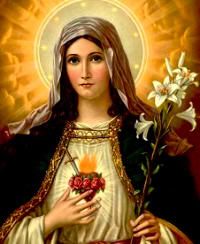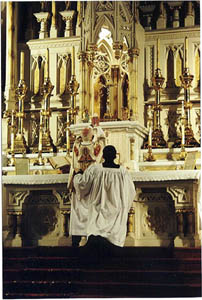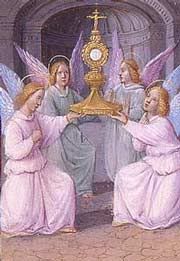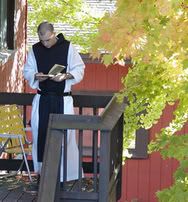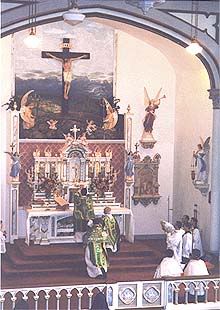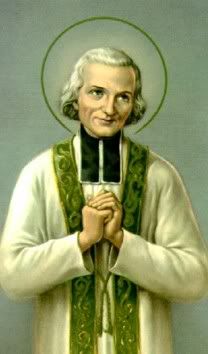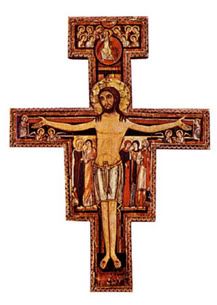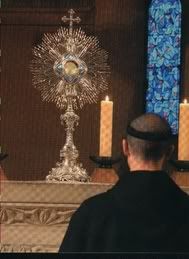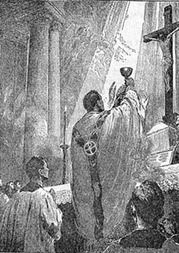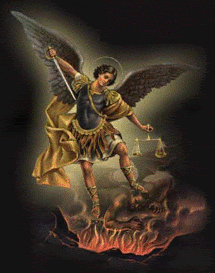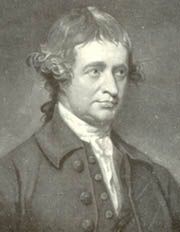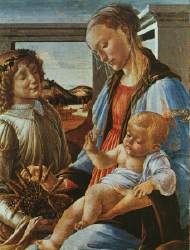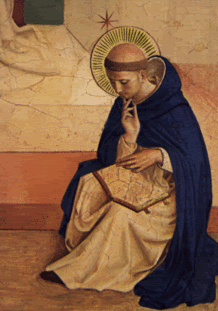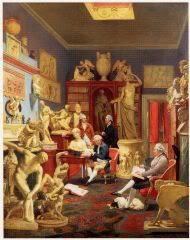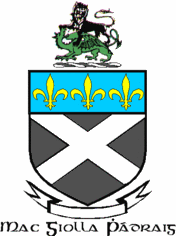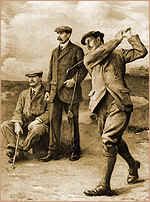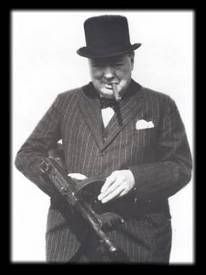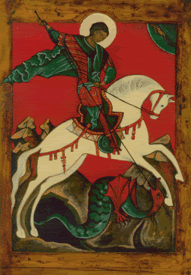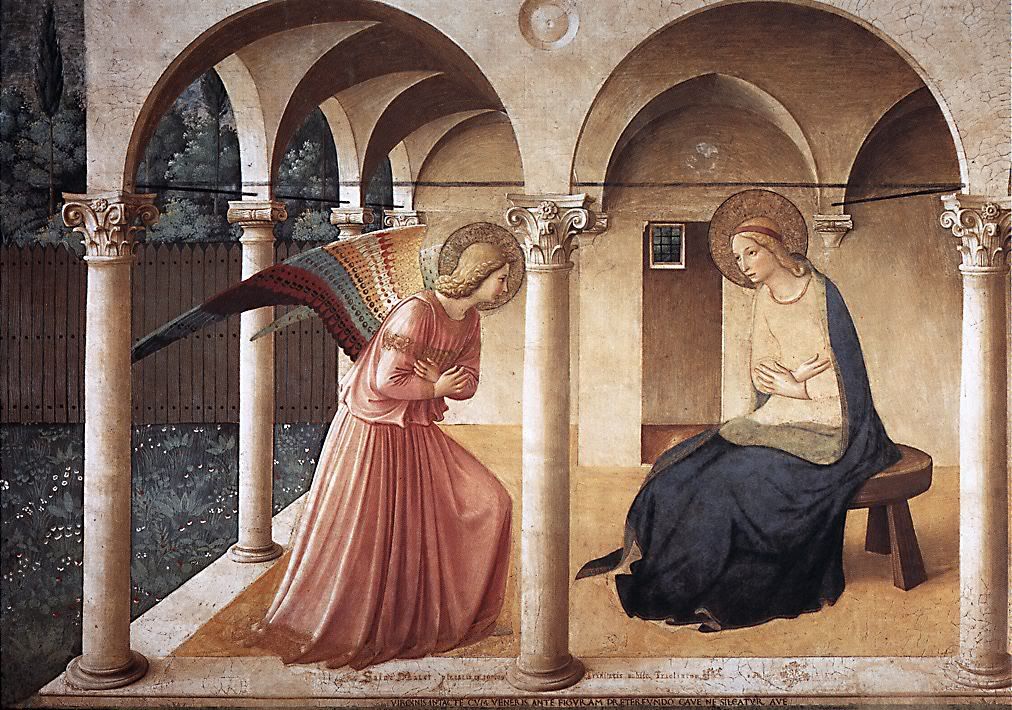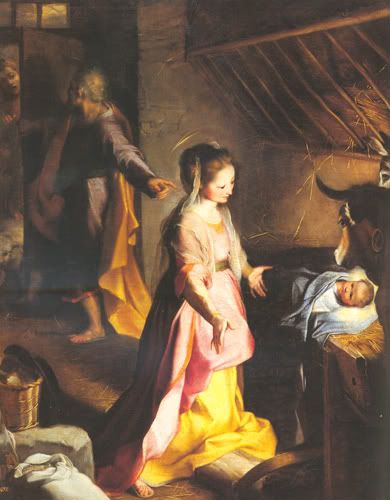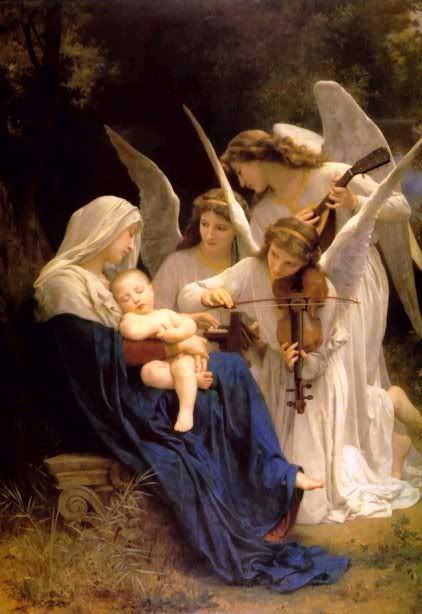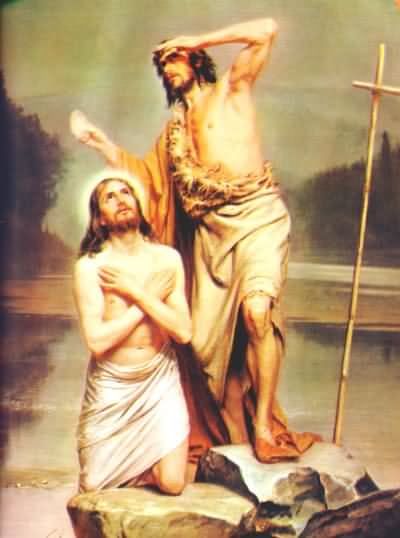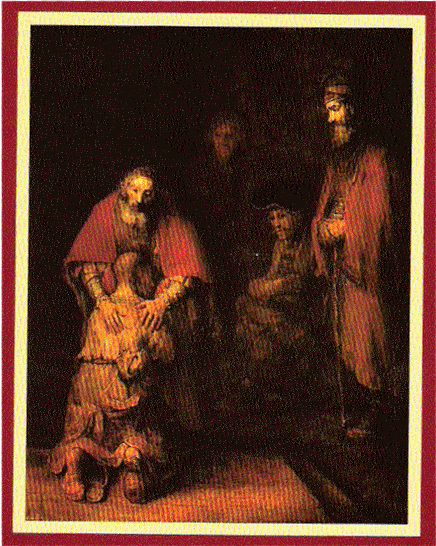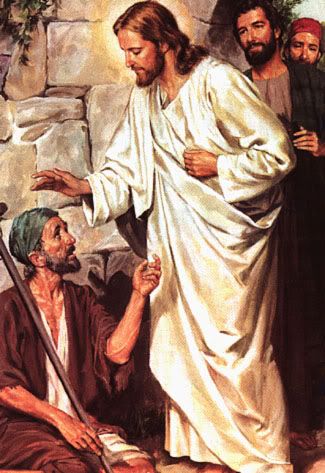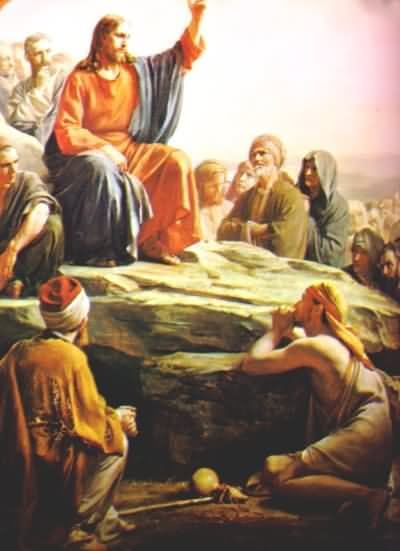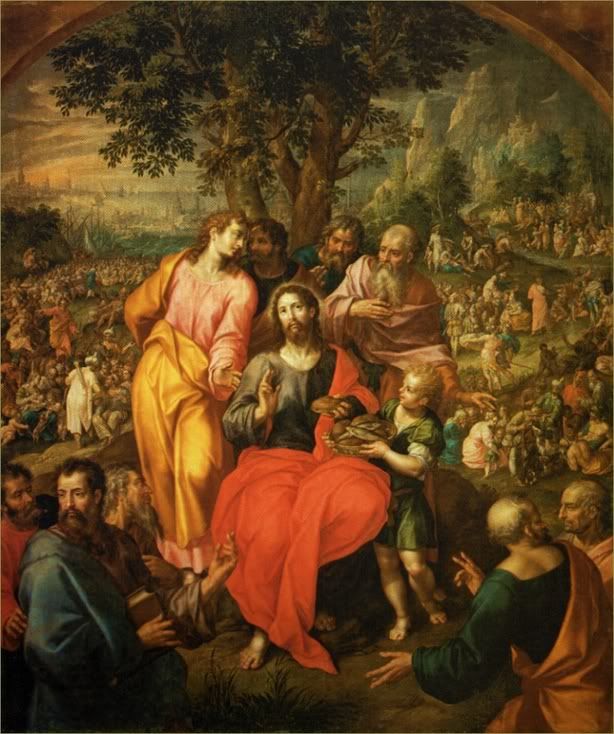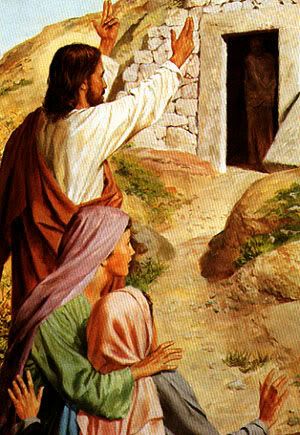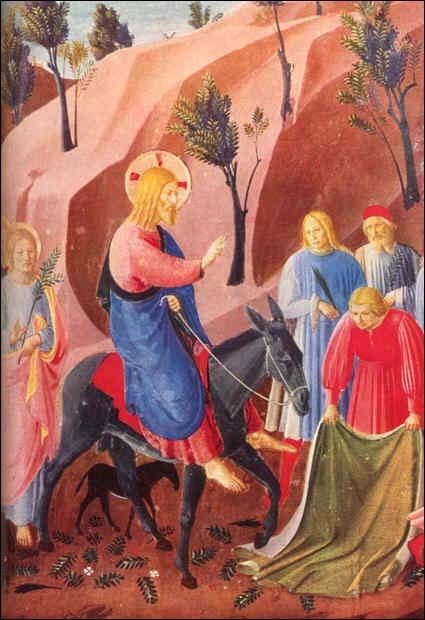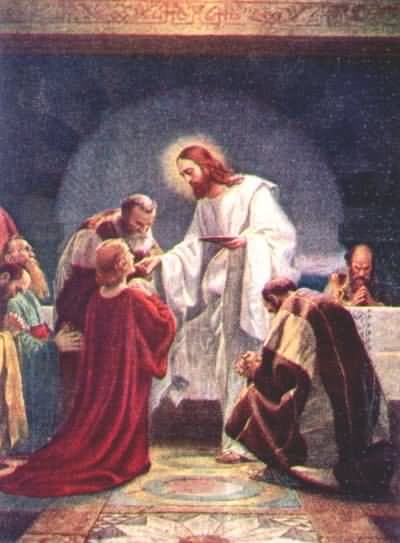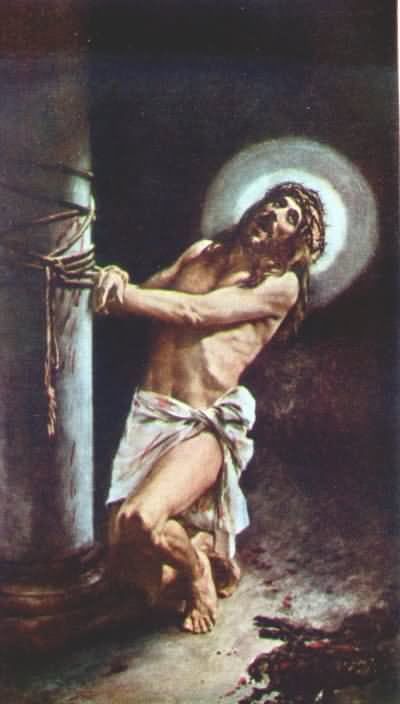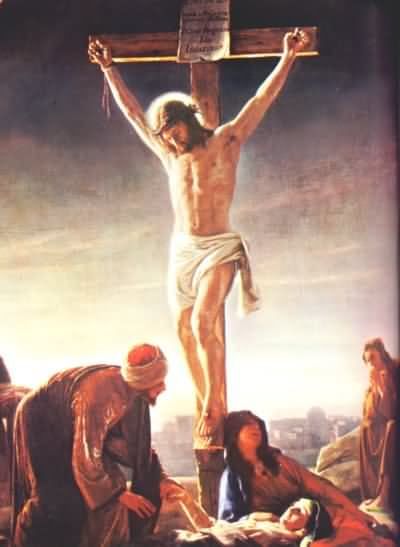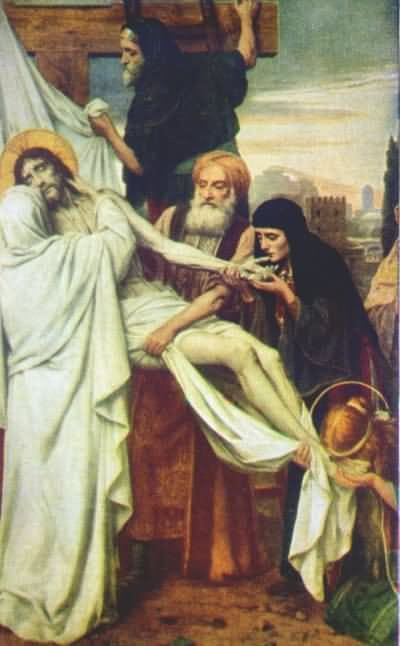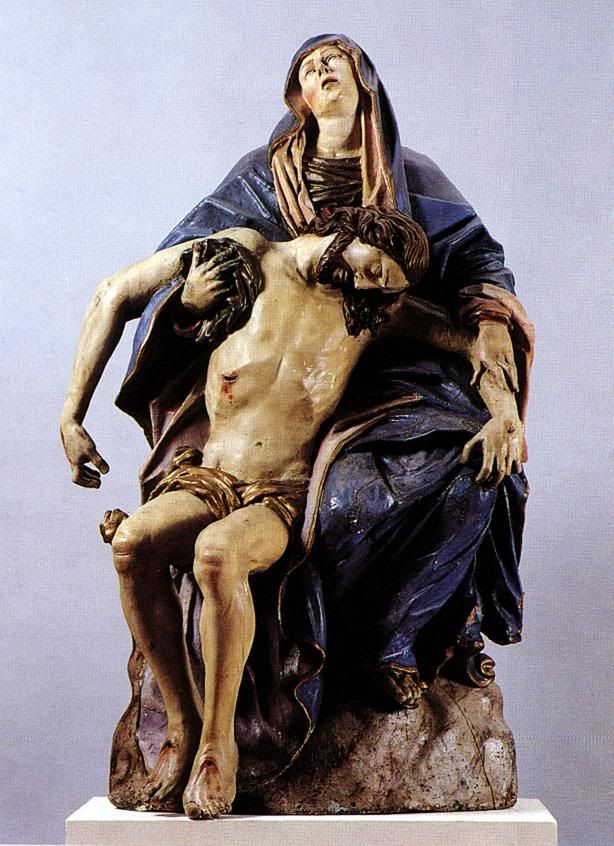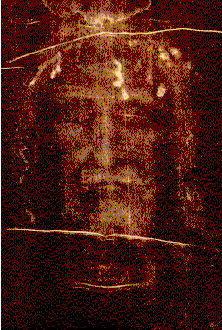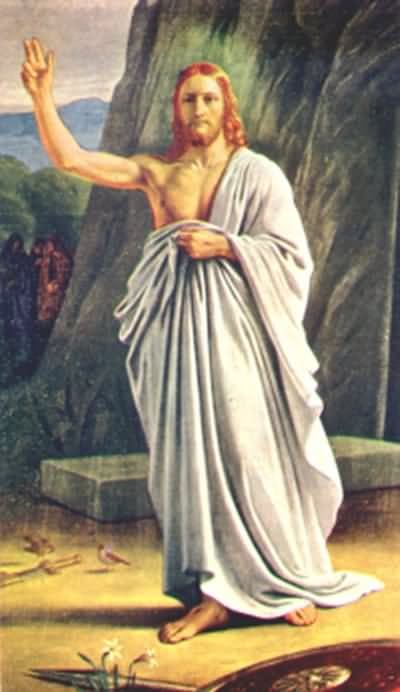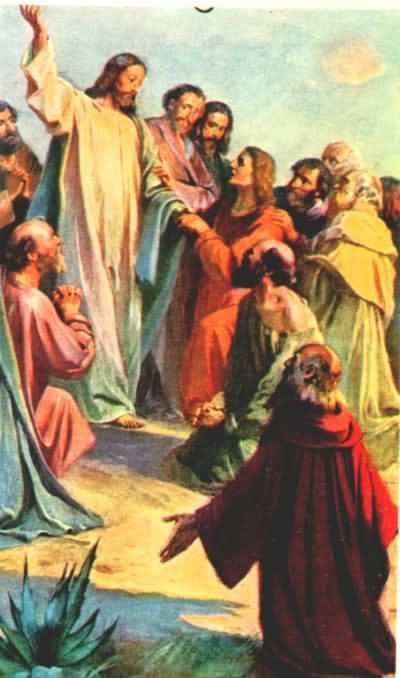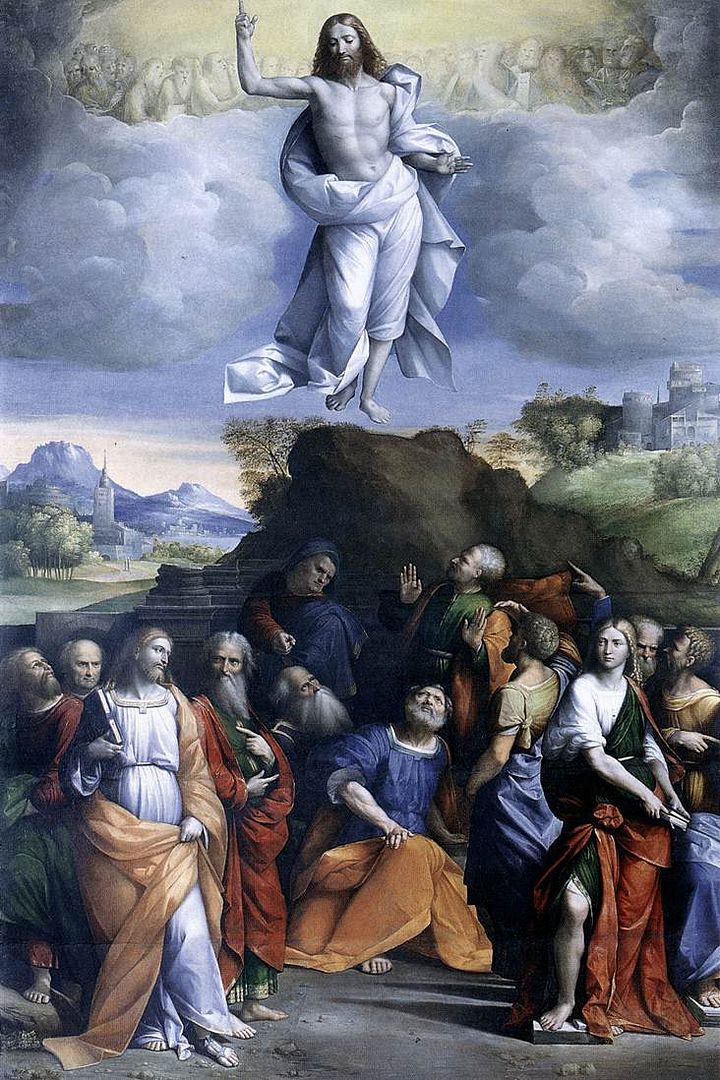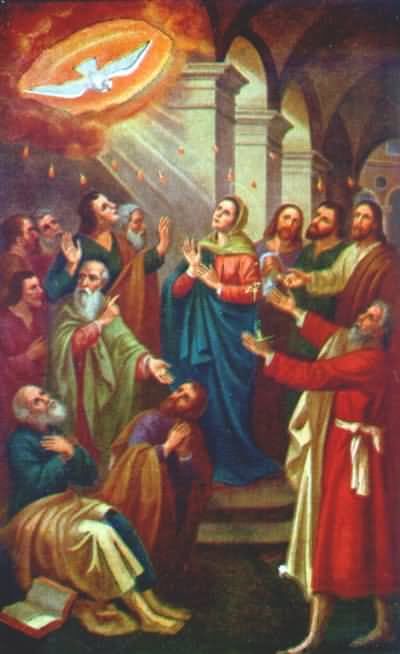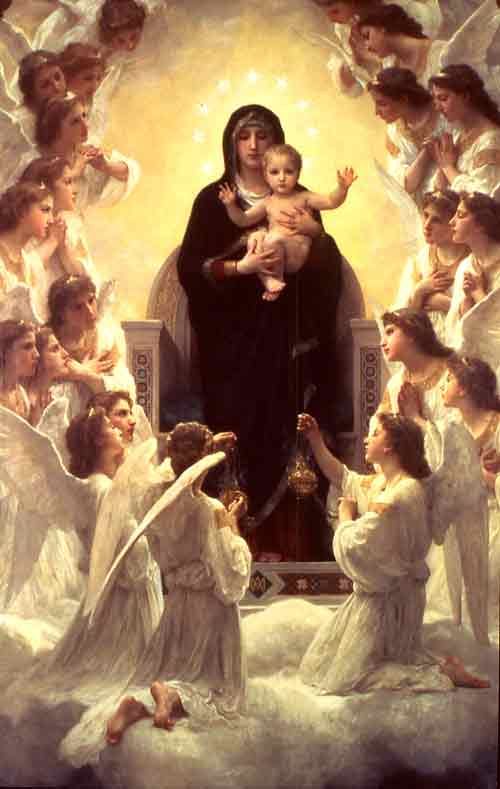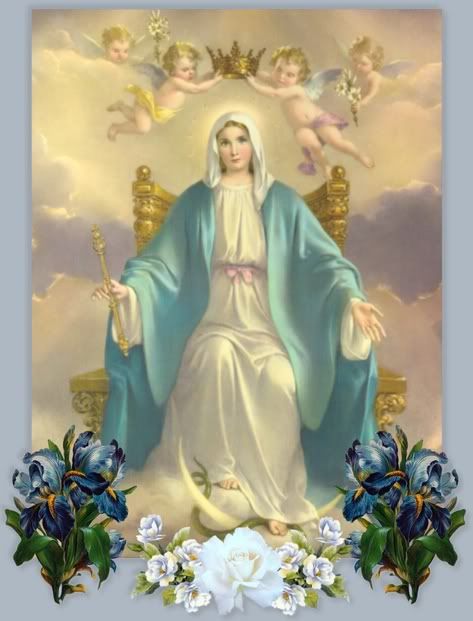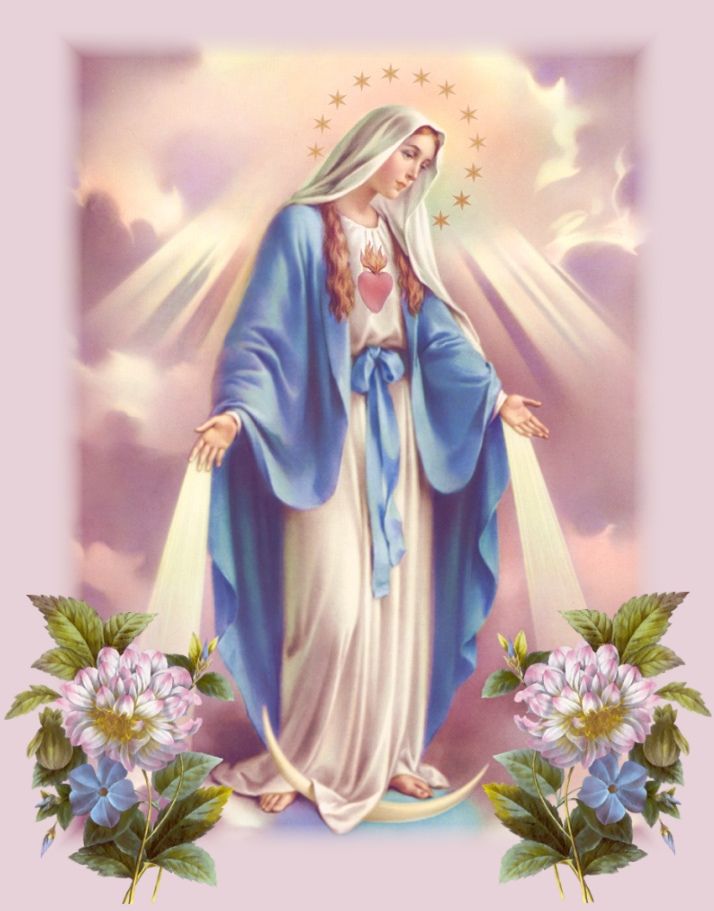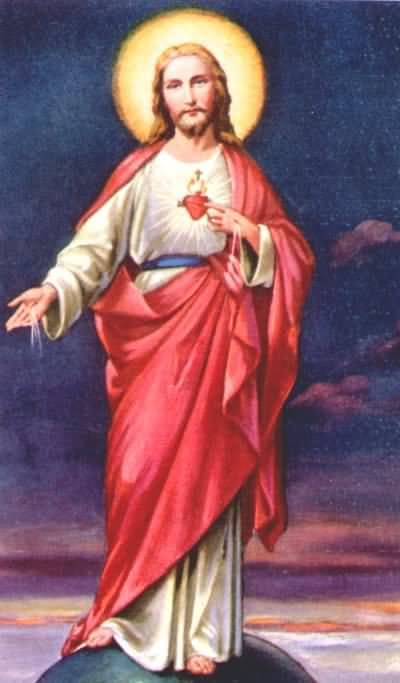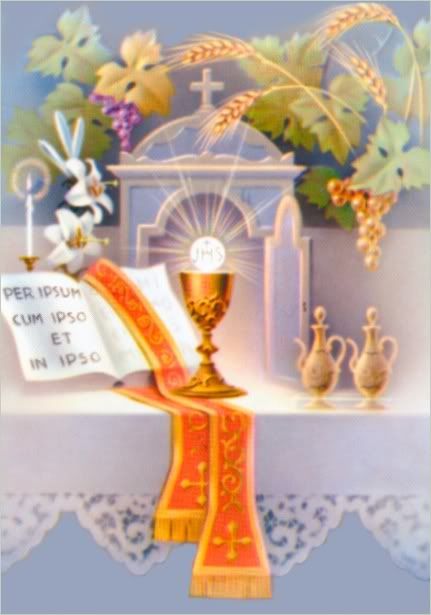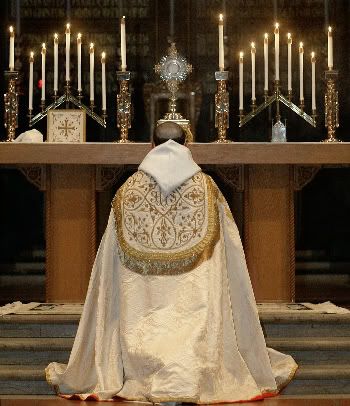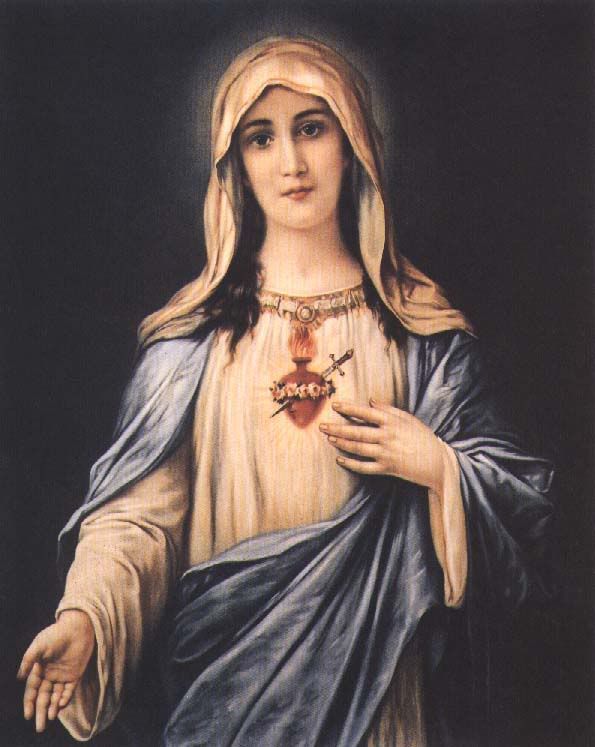Saturday, May 15, 2010
Daily Marian Prayer And Image

From The Glories O Mary, by Saint alphonsus de Liguori:
O great Mother of my Lord, I see full well that my ingratitude towards God and thee, and this too for so many years, has merited for me that thou shouldst justly abandon me, and no longer have a care of me, for an ungrateful soul is no longer worthy of favors. But I, O Lady, have a high idea of thy great goodness; I believe it to be far greater than my ingratitude. Continue, then, O refuge of sinners, and cease not to help a miserable sinner who confides in thee.
O Mother of mercy, deign to extend a helping hand to a poor fallen wretch who asks thee for pity. O Mary, either defend me thyself, or tell me to whom I can have recourse, and who is better able to defend me than thou, and where I can find with God a more clement and powerful advocate than thou, who art his Mother. Then, in becoming the Mother of our Savior, wast thereby made the fitting instrument to save sinners, and wast given me for my salvation.
O Mary, save him who has recourse to thee. I deserve not thy love, but it is thine own desire to save sinners, that makes me hope that thou lovest me. And if thou lovest me, how can I be lost? O my own beloved Mother, if by thee I save my soul, as I hope to do, I shall no longer be ungrateful, I shall make up for my past ingratitude, and for the love which thou hast shown me, by my everlasting praises, and all the affections of my soul.
Happy in heaven, where thou reignest, and wilt reign forever. I shall always sing thy mercies, and kiss for eternity those loving hands which have delivered me from hell, as often as I have deserved it by my sins. O Mary, my liberator, my hope, my Queen, my advocate, my own sweet Mother, I love thee; I desire thy glory, and I love thee forever.
Amen. Amen. Thus do I hope.
Labels: Our Blessed Lady
Novena To the Holy Ghost, Day 2
Second Day:
Come, O blessed Spirit of Holy Fear, penetrate my inmost heart, that I may set Thee, my Lord and God, before my face forever; help me to shun all things that can offend Thee, and make me worthy to appear before the pure eyes of Thy Divine Majesty in heaven, where Thou livest and reignest in the unity of the ever Blessed Trinity, God world without end. Amen.
Recite one Our Father, one Hail Mary, and seven Glory Be's
Come, O blessed Spirit of Holy Fear, penetrate my inmost heart, that I may set Thee, my Lord and God, before my face forever; help me to shun all things that can offend Thee, and make me worthy to appear before the pure eyes of Thy Divine Majesty in heaven, where Thou livest and reignest in the unity of the ever Blessed Trinity, God world without end. Amen.
Recite one Our Father, one Hail Mary, and seven Glory Be's
Labels: Novenas
Friday, May 14, 2010
Friday At the Foot Of the Cross

Deliver me, Lord Jesus Christ, from all my iniquities and from every evil, make me hold ever fast to Thy commandments and never allow me to be separated from Thee. Amen.
Labels: Friday At the Foot Of the Cross
Daily Marian Prayer And Image

From The Glories Of Mary, by Saint Alphonsus de Liguori:
I will address thee, O great Mother of God, in the words of St. Bernard: "Speak, O Lady, for thy Son heareth thee, and whatever thou askest thou wilt obtain" ("Loquere, Domina, quia audit Filius tuus; et quaecumque petieris, impetrabis"—Depr. Ad gl. V.)
Speak, speak, then, O Mary, our advocate, in favor of us poor miserable creatures. Remember that it was also for our good that thou didst receive so great power and so high a dignity. A God was pleased to become thy debtor by taking humanity of thee, in order that thou mightest dispense at will the riches of divine mercy to sinners.
We are thy servants, devoted in a special manner to thee; and I am one of these, I trust, even in a higher degree. We glory in living under thy protection. Since thou dost good to all, even to those who neither know nor honor thee, nay, more, to those who outrage and blaspheme thee, how much more may we not hope from thy benignity, which seeks out the wretched in order to relieve them, we who honor, love, and confide in thee?
We are great sinners, but God has enriched thee with compassion and power far exceeding our iniquities. Thou canst, and hast the will to save us; and the greater is our unworthiness, the greater shall be our hope in order to glorify thee the more in heaven, when by thy intercession we get there.
O Mother of mercy, we present thee our souls, once cleansed and rendered beautiful in the blood of Jesus Christ, but, alas, since that time, defiled by sin. To thee do we present them; do thou purify them. Obtain for us true conversion; obtain for us the love of God, perseverance, heaven.
We ask thee for much; but what is it? perhaps thou canst not obtain all? It is perhaps too much for the love God bears thee? Ah, no! for thou hast only to open thy lips and ask thy divine Son; he will deny thee nothing. Pray, then: and we shall with the same certainty obtain the kingdom of heaven.
Amen.
Labels: Our Blessed Lady
Novena To the Holy Ghost, Day 1
First Day:
Almighty and eternal God, Who hast vouchsafed to regenerate us by water and the Holy Ghost, and hast given us forgiveness of all our sins, vouchsafe to send forth from heaven upon us Thy sevenfold Spirit, the Spirit of Wisdom and Understanding, the Spirit of Counsel and Fortitude, the Spirit of Knowledge and Piety, and fill us with the Spirit of Holy Fear. Amen.
Recite one Our Father, one Hail Mary, and seven Glory Be's
Almighty and eternal God, Who hast vouchsafed to regenerate us by water and the Holy Ghost, and hast given us forgiveness of all our sins, vouchsafe to send forth from heaven upon us Thy sevenfold Spirit, the Spirit of Wisdom and Understanding, the Spirit of Counsel and Fortitude, the Spirit of Knowledge and Piety, and fill us with the Spirit of Holy Fear. Amen.
Recite one Our Father, one Hail Mary, and seven Glory Be's
Labels: Novenas
Thursday, May 13, 2010
Daily Marian Prayer And Image

From The Glories Of Mary, by Saint Alphonsus de Liguori:
O Queen and Mother of mercy, who dispensest graces to all who have recourse to thee with so much liberality, because thou art a Queen, and with so much love, because thou art our most loving Mother; to thee do I, who am so devoid of merit and virtue, and so loaded with debts to the divine justice, recommend myself this day.
O Mary, thou holdest the keys of all the divine mercies; forget not my miseries, and leave me not in my poverty. Thou art so liberal with all, and givest more than thou art asked for, O, be thus liberal with me.
O Lady, protect me; this is all that I ask of thee. If thou protectest me, I fear nothing. I fear not the evil spirits; for thou art more powerful than all of them. I fear not my sins; for thou by one word canst obtain their full pardon from God. And if I have thy favor, I do not even fear an angry God; for a single prayer of thine will appease him. In fine, if thou protectest me, I hope all; for thou art all-powerful.
O Mother of mercy, I know that thou takest pleasure and dost glory in helping the most miserable, and, provided they are not obstinate, that thou canst help them. I am a sinner, but am not obstinate; I desire to change my life. Thou canst, then, help me; O, help me and save me. I now place myself entirely in thy hands. Tell me what I msut do in order to please God, and I am ready for all, and hope to do all with thy help, O Mary—Mary my Mother, my light, my consolations, my refuge, my hope.
Amen. Amen. Amen.
Labels: Our Blessed Lady
Ascension Thursday

Happily, the Archdiocese of Boston adheres to the old rule, that the Ascension falls 40 days after Easter, on a Thursday. And even if it didn't, since I follow the 1962 Ordo (with some exceptions and additions) today would still be Ascension Thursday, a holy day of obligation.
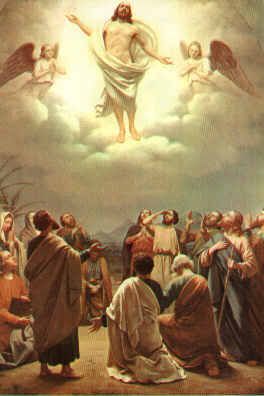
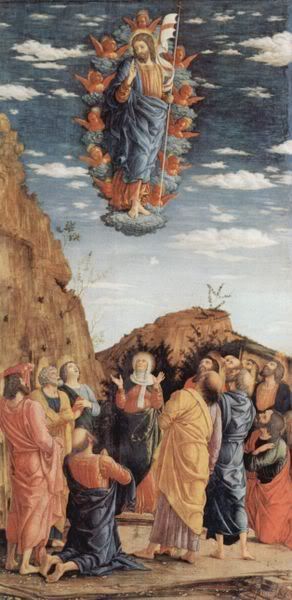
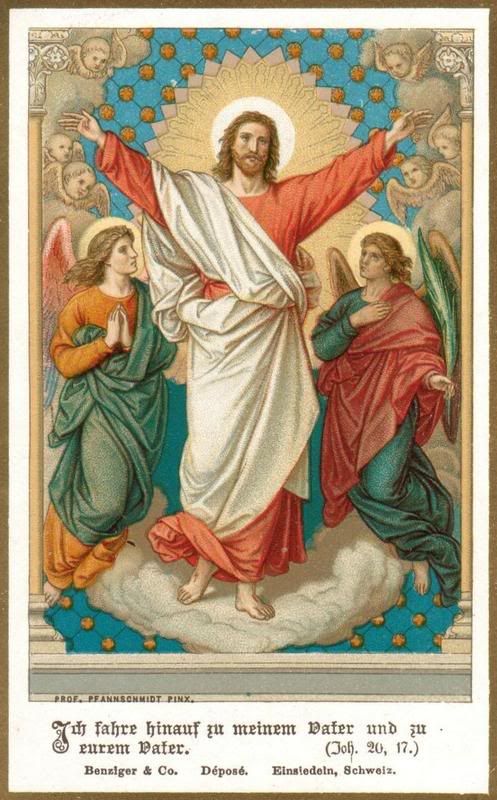
Images in my primary Photobucket account will be back up before the 15th. We've exceeded the monthly allotment of bandwith, but the account renews some time on the 14th.
Labels: The Liturgical Year
Wednesday, May 12, 2010
Daily Marian Prayer And Image

From The Glories Of Mary, by Saint Alphonsus de Liguori:
O my soul, see what a sure hope of salvation and eternal life our Lord has given thee, by having in his mercy inspired thee with confidence in the patronage of his mother; and this, notwithstanding that so many times by thy sins thou hast merited his displeasure and hell.
Thank thy God, and thank thy protectress Mary, who has condescended to take thee under her mantle; for of this thou mayest be well convinced, after the many graces that thou hast received by her means. O yes, I do thank thee, my most loving Mother, for all thou hast done for me who am deserving of hell. And from how many dangers hast thou not delivered me, O Queen! How many inspirations and mercies hast thou not obtained for me from God! What service, what honor, have I ever rendered thee, that thou shouldst do so much for me? I know that it is thy sole goodness that has impelled thee.
O, too little would it be in comparison with all that I owe thee, did I shed my blood and give my life for thee; for thou hast delivered me from eternal death; thou hast enabled me, as I hope, to recover divine grace; to thee, in fine, I owe all I have.
My most amiable Lady, I, poor wretch that I am, can make thee no return but that of always loving and praising thee. Disdain not to accept the tender affection of a poor sinner, who is inflamed with love for thy goodness. If my heart is unworthy to love thee, because it is impure and filled with earthly affecgions, it is thou who must change it. Change it, then. Bind me to my God, and bind me so that I may never more have it in my power to separate myself from his love. Thou askest of me that I should love thy Godk, and I ask of thee that thou shouldst obtain this love for me, to love him always; this is all that I desire.
Amen.
Labels: Our Blessed Lady
Tuesday, May 11, 2010
Daily Marian Prayer and Image

From The Glories Of Mary, by Saint Alphonsus de Liguori:
Behold at thy feet, O Mary my hope, a poor sinner, who has so many times been by his own fault the slave of hell. I know that by neglecting to have recourse to thee, my refuge, I allowed myself to be overcome by the devil. Had I always had recourse to thee, had I always invoked thee, I certainly should not have fallen.
I trust, O Lady most worthy of all our love, that through thee I have already escaped from the hands of the devil, and that God has pardoned me. But I tremble lest at some future period I may again fall into the same bonds. I know that my enemies have not lost the hope of again overcoming me, and already they prepare new assaults and temptations for me.
O, my Queen and refuge, do thou assist me. Place me under thy mantle; permit me not again to become their slave. I know that thou wilt help me and give me the victory, provided I invoke thee; but I dread lest in my temptations I may forget thee, and neglect to do so.
The favor, then, that I seek of thee, and which thou must grant me, O most holy Virgin, is that I may never forget thee, and especially in time of temptation; grant that I may then repeatedly invoke thee, saying, "O Mary, help me; O Mary, help me."
And when my last struggle with hell comes, at the moment of death, then, my Queen, help me more than ever, and thou thyself remind me to call on thee more frequently either with my lips or in my heart; that, being thus filled with confidence, I may expire with thy sweet name and that of thy Son Jesus on my lips; that so I may be able to bless thee and praise thee, and not depart from thy feet in Paradise for all eternity.
Amen.
Labels: Our Blessed Lady
Monday, May 10, 2010
Daily Marian Prayer And Image

From The Glories Of Mary, by Saint Alphonsus de Liguori:
O Mother of God, Queen of angels and hope of men, give ear to one who calls upon thee and has recourse to thy protection. Behold me this day prostrate at thy feet; I, a miserable slave of hell, devote myself entirely to thee. I desire to be forever thy servant. I offer myself to serve and honor thee to the utmost of my power during the whole of my life.
I know that the service of one so vile and miserable can be no honor to thee, since I have so grievously offended Jesus, thy Son and my Redeemer. But if thou wilt accept one so unworthy for thy servant, and by thy intercession change me, and thus making me worthy, this very mercy will give thee that honor which so miserable a wretch as I can never give thee.
Receive me, then, and reject me not, O my Mother. The Eternal Word came from heaven on earth to seek for lost sheep, and to save them he became thy Son. And when one of them goes to thee to find Jesus, wilt thou despise it?
The price of my salvation is already paid; my Savior has already shed his blood, which suffices to save an infinity of worlds. This blood has only to be applied even to such a one as I am. And that is thy office, O Blessed Virgin; to thee does it belong, as I am told by St. Bernard, to dispense the merits of this blood to whom thou pleasest. To thee does it belong, says St. Bonaventure, to save whomsoever thou willest, "whomsoever thou willest will be saved" ("Quem vis, ipse salvus erit").
Oh, then, help me, my Queen; my Queen, save me. To thee do I this day consecrate my whole soul; do thou save it. O salvation of those who invoke thee, I conclude in the words of the same saint, "O salvation of those who call upon thee, do thou save me" ("O Salus te invocantium!").
Amen.
Labels: Our Blessed Lady
Rogationtide
Monday, Tuesday, and Wednesday of this week are Rogationtide.
Check out what Holy Trinity's website has to say about the Rogation Days.
There used to be a partial indulgence for reciting the Litany of the Saints (link to Recta Ratio: The Yahoo Group) even privately during Rogationtide, since Rogation Processions are few and far between these days.

Rogation Procession at Papa Stronsay. However, the monks are virtually the only Catholic human inhabitants of the island, so what is missing is a Catholic lay community following the procession.
Here is the commentary of Father Francis X. Weiser, SJ on Rogationtide from his classic work, Handbook Of Christian Feasts and Customs. Father Weiser was at one time pastor of Holy Trinity church, now Boston's indult parish.
CHAPTER 4: ROGATION DAYS
ORIGIN AND HISTORY
LITANIES--The Jews in the Old Testament had a form of public prayer in which one or more persons would pronounce invocations of God which all those present answered by repeating (after every invocation) a certain prayer call, lik e "His mercy endures forever" (Psalm 135) or "Praise and exalt Him above all forever" (Daniel 3, 57-87).
In the New Testament the Church retained this practice. The early Christians called such common, public, and alternating prayers "litany," from the Greek "litaneia" (lite), meaning "a humble and fervent appeal."[1] What they prayed for is indicated in a short summary by Saint Paul in his first letter to Timothy (2, 1-2).
The common and typical structure of the litany in the Latin Church developed gradually, from the third century on, from short invocations as they were used in early Church services. It consisted of four main types, which were recited ei ther separately or joined together. First, invocations of the Divine Persons and of Christ, with the response "Miserere nobis" (Have mercy on us). Second, invocations of Mary, the Apostles, and groups of saints, response: "Ora pro nobis" (Pray for us). Th ird, prayers to God for protection from evils of body and soul, response: "Libera nos, Domine" (Deliver us, O Lord). Finally, prayers for needed favors, response: "Te rogamus, audi nos" (We beseech Thee, hear us).[2]
Many invocations of individual saints and special petitions were added everywhere in later centuries, and popular devotion increased their numbers to such an extent that Pope Clement VIII, in 1601, determined the official text of the li tany (called "Litany of All Saints") and prohibited the public use of any other litanies unless expressly approved by Rome.[3]
The invocation Kyrie eleison came from the Orient to Rome in the fifth century. It soon acquired such popularity that it joined (and even supplanted) the older form of litany in the Mass of the Catechumens.[4] Up to this day the Kyrie e leison and Christe eleison in the Mass remain as relics of the responses that the people gave to petitions recited by the deacon (before the readings) and by the celebrant (after the Gospel). Outside of the Holy Sacrifice, the Kyrie eleison was also added to the other types of litany prayers; it may still be found at the beginning and end of every litany. The Greek Rite still uses a number of actual litanies (Ektenai) in its liturgy (the Holy Sacrifice).[5]
Many and varied are the occasions on which litanies were in use among early Christians. Besides being a part of the Mass liturgy, a litany was recited before solemn baptism (as it is today in the liturgy of the Easter vigil) and in the prayers for the dying (where it is also still prescribed). Even more frequent, however, was the use of litanies during processions, because the short invocations and exclamatory answers provided a convenient form of common prayer for a multitude in motion .[6] This connection between litany and procession soon brought about the custom of calling both by the same term. From the sixth century on, "litania" was used with the meaning of "procession." The first Council of Orleans (511) incorporated this usage i nto the official terminology of the Church.[7]
Since the ancient Roman Church had many and divers kinds of processions, the litanies must have been a most familiar feature of ecclesiastical life. Litanies (processions) were held on Station days, every day in Lent, on many feasts, on Ember Days and vigils, and on special occasions (calamities and dangers of a usual or unusual kind) when God's mercy and protection was implored with particular fervor.[8] These latter occasions had already been observed in pagan Rome with processions to the shrines of gods at certain times of the year. Their natural features (dates, routes, motives) were part of the traditional community life. These features the Church retained in certain cases, filling them with the significance and spiritual power of Christian worship.
THE MAJOR LITANIES--The pagan Romans had two kinds of religious parades: the "amburbalia" (around the city) and "ambarvalia" (around the fields).[9] The most important one of the rural processions every year (on April 25) walked along the Via Claudia to a place four miles outside the city. Its purpose was to obtain protection against frost and blight for the field fruits, especially grains. The Roman god responsible for this harvest was a bisexual divinity invoked either as male or female (Robigus, Robigo). He (or she) had the power to send blight upon the grains; and the procession was made to avert his "evil eye" from the fruits of human toil.[10] At the fifth milestone, beyond the Milvian Bridge, was a grove which served as a shrine of Robigus. There the parade stopped, and the "Flamen" (pagan priest) sacrificed a sheep and a rust-colored dog, offering the entrails of these animals to the god. After the "service," young and old celebrated a kind of picnic with games, races, an d amusements (some of which were not overly decent). In honor of the god the whole celebration was called "Robigalia."[11]
Christianity had no quarrel with the motive of such a procession (prayer for protection of the harvest) or with its traditional date and route. Thus, when the empire turned Christian in the fourth century and the pagan celebrations died a natural death, the Church took over this traditional observance, as a Christian rite, to pray for God's protection and blessing upon the fields. The pope with his clergy and a great crowd of people marched in solemn procession along the same route. The y chanted the litany and repeated every invocation. After crossing the Milvian Bridge they did not, however, proceed to the place where the shrine of Robigus had been, but turned back and wended their way along the Tiber to the church of St. Peter at the Vatican. There the pope offered the Holy Sacrifice, and the multitude attended.[12]
When and how, after the pagan observance had stopped, the Church started this annual procession is not known. The first definite information is given in a sermon of Pope Gregory the Great (604), who called it a "Litania Major" (Greater Litany); and he speaks of the "return of this annual solemnity," which proves that it already was a traditional feature in his day.[13]
The name "litania major" was originally given to a number of solemn processions in Rome (such as those on April 25 and Ember Fridays).[14] Only later was it applied exclusively to the procession of April 25, and this term has remained i n the liturgy ever since. There is no connection between the Major Litany and the Feast of Saint Mark the Evangelist, which is celebrated on the same day. The litany is of much earlier date, for the Feast of Saint Mark was not introduced until the ninth c entury.[15]
Shortly after the beginning of the Middle Ages, the Major Litany was adopted by other parts of the ancient empire, but not everywhere on the same date. It was only during the ninth and tenth centuries that the Roman date and ritual beca me those usually accepted. For the Frankish empire the observance in the Roman manner was prescribed by the Council of Aachen, in 836.[16] Today the liturgical books use the plural form in all cases, both for the prayers and the processions.[17]
THE MINOR LITANIES--In 470, during a time of unusual calamities (storms, floods, earthquakes), Bishop Mamertus of Vienne in Gaul originated an annual observance of penitential exercises for the three days before the Feast of the Ascension. With the cooperation of the civil authorities he decreed that the faithful abstain from servile work and that this triduum be held as a time of penance, with prayer and fasting. He also prescribed penitential processions (litanies) for each one of the three days. Thus the name "litanies" was given to the whole celebration.[18]
Very soon the other bishops of Gaul adopted the new observance. At the beginning of the sixth century it started spreading into neighboring countries. In 511 the Council of Orleans prescribed it for the Frankish (Merovingian) part of Fr ance.[19] The Diocese of Milan accepted the litanies, but held them in the week before Pentecost.[20] In Spain they were observed in the sixth century during the week after Pentecost.[21] The Council of Mainz (813) introduced them to the German part of th e Frankish empire.[22]
Meanwhile, Rome had declined for centuries to adopt this custom because its liturgical character did not agree with the ancient practice of the Roman Church which excluded penitential rites on all days between Easter and Pentecost. Char lemagne and the Frankish bishops, however, urged Pope Leo III (816) to incorporate these litanies into the Roman liturgy.[23] The pope finally consented to a compromise: the observance of the fast was rescinded, but the penitential procession was approved . As Mass text, the formula of the Major Litany from the Roman liturgical books was taken. This approval was originally made only as an exception, for the litanies were not intended by Leo III as an established annual rite.[24] In return for the concessio n, the Frankish Church decreed, at the Council of Aachen (836), that these "minor litanies" should be held according to the Roman decision (without fast).[25]
During the subsequent centuries, however, the custom of holding these litanies became definitely established, even at Rome, as an annual feature of the liturgical year; it has remained so ever since in the whole Latin Church, and is now celebrated everywhere on the three days before the Feast of the Ascension. A memorable exception has been made recently: Pope Pius XII granted to some Catholic missions in the Pacific Islands the permission to celebrate both the major and minor litanies in October or November.[26]
NAMES--The litanies held on each one of the three days before the Feast of the Ascension are called "minor" because, in the Roman liturgy, they are of younger date than the Major Litany on April 25. In the early centuries they we re also called "Gallican Litanies," because of their origin in Gaul.[27] The Major Litany was named "Roman" or "Gregorian" (after Gregory the Great, who first mentioned it). The popular term "Rogation Days" originated in the High Middle Ages. Another popu lar name, mostly used in central Europe, is "Cross Days" (from the crucifix that is carried in front of the procession).[28]
LITURGY
LATIN RITE--The Rogation Days are unique through their penitential nature (purple vestments, no Gloria) within the jubilant Easter season. Even the Major Litany, which in ancient times was a festive observance of joyful petition and confidence, became assimilated after the beginning of the tenth century, acquiring this note of mourning and penance.[29]
In the chanting of the litanies each invocation is repeated twice, first by the cantors, then by the people (choir). Some scholars explain this custom as a relic of the "Litania Septiformis" (Procession in Seven Columns) from the time o f Pope Gregory the Great, who initiated this particular type of litany.[30] Another feature of the ancient Major Litany was the antiphons, which the cantors sang at the start of the procession. They unfortunately were discontinued centuries ago, so they a re no longer found in our liturgical books.[31]
The litany used to lead directly into the Mass (as it still does on the vigil of Easter). The Rogation Mass, therefore, had neither Introit nor Kyrie of its own, but the priest concluded the litany by singing a Collect which also served as oration (prayer) of the Mass. The ten Collects used now in the litany are of later date, when the procession was severed from the Mass and held as a separate and isolated rite.[32]
There is no obligation now to conduct a procession. However, the rubrics of the Divine Office prescribe that on Rogation Days all those who are obliged to say the breviary must recite the Litanies of All Saints (with the psalm and praye rs following it) whenever they have missed them before Mass.[33]
The Rogations must be commemorated in other Masses on Rogation Days (for instance, in the Mass of Saint Mark the Evangelist). If April 25 should happen to be Easter Sunday, the litanies are transferred to Tuesday in Easter week; apart f rom this exception, they are always to be held on their liturgical dates even if some other great feast should fall on one of their days.[34]
ORIENTAL RITES--Most of the Oriental Churches keep a triduum of fast and penitential prayer, comparable to the Rogations, shortly before the beginning of Lent. In the Greek Rite it is called the "Fast of Adam" in honor of the fir st law of abstinence which God gave to Adam and Eve in Paradise (Genesis 2, 17), and in preparation for the coming strict fast of Lent. About the same time of the year, the Syrians, Chaldeans, and Copts celebrate a three days' penitential season of prayer and fasting which they call the "Fast of Indiction" (because God indicts man, and punishes him through natural calamities) or "Fast of the Ninevites" (because the people of Nineveh averted God's punishment through prayer and fasting; see Jonas 3, 5-10). The Armenians term it "Aratshavor-atz," which means "precursor" (a fast coming before Lent).[35]
FOLKLORE
RELIGIOUS OBSERVANCE--In the rural sections of Catholic countries the Rogations are still held in their full and original significance with many features of external solemnity. The church bells ring while the procession slowly we nds its way through the town and out into the open. Religious banners are carried, the litanies are chanted by choir and people, and the priest sprinkles the fields, gardens, and orchards with holy water. After returning to the church, a sermon is preache d and the High Mass of the Rogations is celebrated. Later in the day some time is spent by many farmers with private little prayer processions around their own homestead. Reciting traditional prayers, the whole family asks for God's blessing upon house, b arns, stables, and fields.[36]
In some places the Rogations are held in a way that is strongly reminiscent of the "Litania Septiformis" of ancient times. The inhabitants of villages surrounding some city or town will proceed from their own churches in separate proces sions and converge toward the big church of the city for the sermon and High Mass. Afterward a market or fair is ready to serve their temporal needs and interests.
The purpose and liturgy of the Rogations has for many centuries, up to our time, inspired a great number of semi-liturgical imitations and repetitions of its rite in the manifold smaller processions which are held all through the summer months in countless places of Europe. These prayer processions are customary whenever the harvest is in danger from frost, floods, hail, drought, or the like.[37] Other such processions are steady features of religious observance, and their main purpose is to pray for the right kind of weather--a most important item on the prayer list of agricultural populations.[38] In many sections of Europe a "weather procession" is held around the church on every Sunday. Usually the priest sings the prologue of Saint John's Gospel (1, 1-14), which from the High Middle Ages has been considered as conferring a powerful blessing against all harmful trends of nature.[39]
PRE-CHRISTIAN ELEMENTS--The pre-Christian lore of averting harm from fields and homes by the magic power of "walking around" them ("circumambulatio," "ambitus" in Latin and "umbigang" in old Germanic) still survives in many super stitious customs among the rural populations of Europe.[40] At the seasons of the year when the demons roam (before the winter solstice, on Walpurgis Night, around the middle of June, at Halloween), girls or young men must circle the fields and orchards, sometimes during the night and in a rhythmic dance step. Before Christmas the farmer goes around his buildings with incense and holy water. He must be careful to complete the round walk; otherwise "the blessing would not take hold." Here also belongs the superstition held in many places that visitors should leave the home by the same door through which they came (to "close the circle") in order to avoid misfortune and harm.[41]
ENDNOTES
1. F. Cabrol, "Litanies," DACL, 9.2 (1930), 1540 ff.
2. Schuster, II, 359.
3. CIC, 1259, 2.
4. Jgn MS, I, 412ff.
5. Nilles, I, LXHI (Ektenes).
6. J. A. Jungmann, "Beitrage zur Geschichte der Gebetsliturgie," VII, ZKTh, 73 (1951), 347ff.
7. Can. 27; Mansi, 8, 355.
8. Kellner, 189 ff.
9. PW, I, 1796 (Ambarvalia), 1816 (Amburbium).
10. M. T. Varro, "Antiquitates, De Rust.," I, 1, 6.
11. PW, IA.1, 949 ff.
12. TE, I, 660.
13. Letter without address; PL, 27, 1327.
14. H. Grisar, "Das Romische Sacramentar," ZKTh, 9 (1885), 585 ff.
15. Kellner, 300.
16. Cap. II, Can. 10; Mansi, 14, 678.
17. H. Leclercq, "Procession de Saint Marc," DACL, 10.2 (1932), 1740 ff.
18. Gregory of Tours, "Historia Francorum" 2, 34; PL, 71, 231 ff.; Sidon. Apoll., Epist. 1; PL, 58, 563.
19. Can. 27; Mansi, 8, 355.
20. Kellner, 193.
21. "Concil. Gerund.," Can. 2; Mansi, 8, 549.
22. Can. 33; Mansi, 14, 72.
23. LE, 164.
24. Schuster, II, 371.
25. See note 16.
26. W. van Bekkum, "The Liturgical Revival in the Service of the Missions," AP, 108.
27. F. Cabrol, "Rogations," DACL, 14.2 (1948), 2459 ff.
28. OiT, 110.
29. Schuster, II, 356.
30. DACL, 10.2 (1932), 1740 (Litania Septiformis).
31. Schuster, II, 358 (text of these ancient antiphons).
32. Schuster, II, 366.
33. BR, April 25 (S. Marci Evangelistae), rubric at the end.
34. MR, April 25 (S. Marci Evangelistae), rubric before Mass text.
35. Nilles, II, 6-11, 51, 646, 697.
36. OiT, 104ff. ("Die drei Bittage vor Christi Himmelfahrt").
37. B. Scholz, "The Sacramentals in Agriculture," OF, 5 (1931), 323 ff.
38. Franz, II, 71.
39. Jgn MS, II, 543.
40. Franz, II, 7, 68.
41. Koren, 129 ff.
Check out what Holy Trinity's website has to say about the Rogation Days.
There used to be a partial indulgence for reciting the Litany of the Saints (link to Recta Ratio: The Yahoo Group) even privately during Rogationtide, since Rogation Processions are few and far between these days.

Rogation Procession at Papa Stronsay. However, the monks are virtually the only Catholic human inhabitants of the island, so what is missing is a Catholic lay community following the procession.
Here is the commentary of Father Francis X. Weiser, SJ on Rogationtide from his classic work, Handbook Of Christian Feasts and Customs. Father Weiser was at one time pastor of Holy Trinity church, now Boston's indult parish.
CHAPTER 4: ROGATION DAYS
ORIGIN AND HISTORY
LITANIES--The Jews in the Old Testament had a form of public prayer in which one or more persons would pronounce invocations of God which all those present answered by repeating (after every invocation) a certain prayer call, lik e "His mercy endures forever" (Psalm 135) or "Praise and exalt Him above all forever" (Daniel 3, 57-87).
In the New Testament the Church retained this practice. The early Christians called such common, public, and alternating prayers "litany," from the Greek "litaneia" (lite), meaning "a humble and fervent appeal."[1] What they prayed for is indicated in a short summary by Saint Paul in his first letter to Timothy (2, 1-2).
The common and typical structure of the litany in the Latin Church developed gradually, from the third century on, from short invocations as they were used in early Church services. It consisted of four main types, which were recited ei ther separately or joined together. First, invocations of the Divine Persons and of Christ, with the response "Miserere nobis" (Have mercy on us). Second, invocations of Mary, the Apostles, and groups of saints, response: "Ora pro nobis" (Pray for us). Th ird, prayers to God for protection from evils of body and soul, response: "Libera nos, Domine" (Deliver us, O Lord). Finally, prayers for needed favors, response: "Te rogamus, audi nos" (We beseech Thee, hear us).[2]
Many invocations of individual saints and special petitions were added everywhere in later centuries, and popular devotion increased their numbers to such an extent that Pope Clement VIII, in 1601, determined the official text of the li tany (called "Litany of All Saints") and prohibited the public use of any other litanies unless expressly approved by Rome.[3]
The invocation Kyrie eleison came from the Orient to Rome in the fifth century. It soon acquired such popularity that it joined (and even supplanted) the older form of litany in the Mass of the Catechumens.[4] Up to this day the Kyrie e leison and Christe eleison in the Mass remain as relics of the responses that the people gave to petitions recited by the deacon (before the readings) and by the celebrant (after the Gospel). Outside of the Holy Sacrifice, the Kyrie eleison was also added to the other types of litany prayers; it may still be found at the beginning and end of every litany. The Greek Rite still uses a number of actual litanies (Ektenai) in its liturgy (the Holy Sacrifice).[5]
Many and varied are the occasions on which litanies were in use among early Christians. Besides being a part of the Mass liturgy, a litany was recited before solemn baptism (as it is today in the liturgy of the Easter vigil) and in the prayers for the dying (where it is also still prescribed). Even more frequent, however, was the use of litanies during processions, because the short invocations and exclamatory answers provided a convenient form of common prayer for a multitude in motion .[6] This connection between litany and procession soon brought about the custom of calling both by the same term. From the sixth century on, "litania" was used with the meaning of "procession." The first Council of Orleans (511) incorporated this usage i nto the official terminology of the Church.[7]
Since the ancient Roman Church had many and divers kinds of processions, the litanies must have been a most familiar feature of ecclesiastical life. Litanies (processions) were held on Station days, every day in Lent, on many feasts, on Ember Days and vigils, and on special occasions (calamities and dangers of a usual or unusual kind) when God's mercy and protection was implored with particular fervor.[8] These latter occasions had already been observed in pagan Rome with processions to the shrines of gods at certain times of the year. Their natural features (dates, routes, motives) were part of the traditional community life. These features the Church retained in certain cases, filling them with the significance and spiritual power of Christian worship.
THE MAJOR LITANIES--The pagan Romans had two kinds of religious parades: the "amburbalia" (around the city) and "ambarvalia" (around the fields).[9] The most important one of the rural processions every year (on April 25) walked along the Via Claudia to a place four miles outside the city. Its purpose was to obtain protection against frost and blight for the field fruits, especially grains. The Roman god responsible for this harvest was a bisexual divinity invoked either as male or female (Robigus, Robigo). He (or she) had the power to send blight upon the grains; and the procession was made to avert his "evil eye" from the fruits of human toil.[10] At the fifth milestone, beyond the Milvian Bridge, was a grove which served as a shrine of Robigus. There the parade stopped, and the "Flamen" (pagan priest) sacrificed a sheep and a rust-colored dog, offering the entrails of these animals to the god. After the "service," young and old celebrated a kind of picnic with games, races, an d amusements (some of which were not overly decent). In honor of the god the whole celebration was called "Robigalia."[11]
Christianity had no quarrel with the motive of such a procession (prayer for protection of the harvest) or with its traditional date and route. Thus, when the empire turned Christian in the fourth century and the pagan celebrations died a natural death, the Church took over this traditional observance, as a Christian rite, to pray for God's protection and blessing upon the fields. The pope with his clergy and a great crowd of people marched in solemn procession along the same route. The y chanted the litany and repeated every invocation. After crossing the Milvian Bridge they did not, however, proceed to the place where the shrine of Robigus had been, but turned back and wended their way along the Tiber to the church of St. Peter at the Vatican. There the pope offered the Holy Sacrifice, and the multitude attended.[12]
When and how, after the pagan observance had stopped, the Church started this annual procession is not known. The first definite information is given in a sermon of Pope Gregory the Great (604), who called it a "Litania Major" (Greater Litany); and he speaks of the "return of this annual solemnity," which proves that it already was a traditional feature in his day.[13]
The name "litania major" was originally given to a number of solemn processions in Rome (such as those on April 25 and Ember Fridays).[14] Only later was it applied exclusively to the procession of April 25, and this term has remained i n the liturgy ever since. There is no connection between the Major Litany and the Feast of Saint Mark the Evangelist, which is celebrated on the same day. The litany is of much earlier date, for the Feast of Saint Mark was not introduced until the ninth c entury.[15]
Shortly after the beginning of the Middle Ages, the Major Litany was adopted by other parts of the ancient empire, but not everywhere on the same date. It was only during the ninth and tenth centuries that the Roman date and ritual beca me those usually accepted. For the Frankish empire the observance in the Roman manner was prescribed by the Council of Aachen, in 836.[16] Today the liturgical books use the plural form in all cases, both for the prayers and the processions.[17]
THE MINOR LITANIES--In 470, during a time of unusual calamities (storms, floods, earthquakes), Bishop Mamertus of Vienne in Gaul originated an annual observance of penitential exercises for the three days before the Feast of the Ascension. With the cooperation of the civil authorities he decreed that the faithful abstain from servile work and that this triduum be held as a time of penance, with prayer and fasting. He also prescribed penitential processions (litanies) for each one of the three days. Thus the name "litanies" was given to the whole celebration.[18]
Very soon the other bishops of Gaul adopted the new observance. At the beginning of the sixth century it started spreading into neighboring countries. In 511 the Council of Orleans prescribed it for the Frankish (Merovingian) part of Fr ance.[19] The Diocese of Milan accepted the litanies, but held them in the week before Pentecost.[20] In Spain they were observed in the sixth century during the week after Pentecost.[21] The Council of Mainz (813) introduced them to the German part of th e Frankish empire.[22]
Meanwhile, Rome had declined for centuries to adopt this custom because its liturgical character did not agree with the ancient practice of the Roman Church which excluded penitential rites on all days between Easter and Pentecost. Char lemagne and the Frankish bishops, however, urged Pope Leo III (816) to incorporate these litanies into the Roman liturgy.[23] The pope finally consented to a compromise: the observance of the fast was rescinded, but the penitential procession was approved . As Mass text, the formula of the Major Litany from the Roman liturgical books was taken. This approval was originally made only as an exception, for the litanies were not intended by Leo III as an established annual rite.[24] In return for the concessio n, the Frankish Church decreed, at the Council of Aachen (836), that these "minor litanies" should be held according to the Roman decision (without fast).[25]
During the subsequent centuries, however, the custom of holding these litanies became definitely established, even at Rome, as an annual feature of the liturgical year; it has remained so ever since in the whole Latin Church, and is now celebrated everywhere on the three days before the Feast of the Ascension. A memorable exception has been made recently: Pope Pius XII granted to some Catholic missions in the Pacific Islands the permission to celebrate both the major and minor litanies in October or November.[26]
NAMES--The litanies held on each one of the three days before the Feast of the Ascension are called "minor" because, in the Roman liturgy, they are of younger date than the Major Litany on April 25. In the early centuries they we re also called "Gallican Litanies," because of their origin in Gaul.[27] The Major Litany was named "Roman" or "Gregorian" (after Gregory the Great, who first mentioned it). The popular term "Rogation Days" originated in the High Middle Ages. Another popu lar name, mostly used in central Europe, is "Cross Days" (from the crucifix that is carried in front of the procession).[28]
LITURGY
LATIN RITE--The Rogation Days are unique through their penitential nature (purple vestments, no Gloria) within the jubilant Easter season. Even the Major Litany, which in ancient times was a festive observance of joyful petition and confidence, became assimilated after the beginning of the tenth century, acquiring this note of mourning and penance.[29]
In the chanting of the litanies each invocation is repeated twice, first by the cantors, then by the people (choir). Some scholars explain this custom as a relic of the "Litania Septiformis" (Procession in Seven Columns) from the time o f Pope Gregory the Great, who initiated this particular type of litany.[30] Another feature of the ancient Major Litany was the antiphons, which the cantors sang at the start of the procession. They unfortunately were discontinued centuries ago, so they a re no longer found in our liturgical books.[31]
The litany used to lead directly into the Mass (as it still does on the vigil of Easter). The Rogation Mass, therefore, had neither Introit nor Kyrie of its own, but the priest concluded the litany by singing a Collect which also served as oration (prayer) of the Mass. The ten Collects used now in the litany are of later date, when the procession was severed from the Mass and held as a separate and isolated rite.[32]
There is no obligation now to conduct a procession. However, the rubrics of the Divine Office prescribe that on Rogation Days all those who are obliged to say the breviary must recite the Litanies of All Saints (with the psalm and praye rs following it) whenever they have missed them before Mass.[33]
The Rogations must be commemorated in other Masses on Rogation Days (for instance, in the Mass of Saint Mark the Evangelist). If April 25 should happen to be Easter Sunday, the litanies are transferred to Tuesday in Easter week; apart f rom this exception, they are always to be held on their liturgical dates even if some other great feast should fall on one of their days.[34]
ORIENTAL RITES--Most of the Oriental Churches keep a triduum of fast and penitential prayer, comparable to the Rogations, shortly before the beginning of Lent. In the Greek Rite it is called the "Fast of Adam" in honor of the fir st law of abstinence which God gave to Adam and Eve in Paradise (Genesis 2, 17), and in preparation for the coming strict fast of Lent. About the same time of the year, the Syrians, Chaldeans, and Copts celebrate a three days' penitential season of prayer and fasting which they call the "Fast of Indiction" (because God indicts man, and punishes him through natural calamities) or "Fast of the Ninevites" (because the people of Nineveh averted God's punishment through prayer and fasting; see Jonas 3, 5-10). The Armenians term it "Aratshavor-atz," which means "precursor" (a fast coming before Lent).[35]
FOLKLORE
RELIGIOUS OBSERVANCE--In the rural sections of Catholic countries the Rogations are still held in their full and original significance with many features of external solemnity. The church bells ring while the procession slowly we nds its way through the town and out into the open. Religious banners are carried, the litanies are chanted by choir and people, and the priest sprinkles the fields, gardens, and orchards with holy water. After returning to the church, a sermon is preache d and the High Mass of the Rogations is celebrated. Later in the day some time is spent by many farmers with private little prayer processions around their own homestead. Reciting traditional prayers, the whole family asks for God's blessing upon house, b arns, stables, and fields.[36]
In some places the Rogations are held in a way that is strongly reminiscent of the "Litania Septiformis" of ancient times. The inhabitants of villages surrounding some city or town will proceed from their own churches in separate proces sions and converge toward the big church of the city for the sermon and High Mass. Afterward a market or fair is ready to serve their temporal needs and interests.
The purpose and liturgy of the Rogations has for many centuries, up to our time, inspired a great number of semi-liturgical imitations and repetitions of its rite in the manifold smaller processions which are held all through the summer months in countless places of Europe. These prayer processions are customary whenever the harvest is in danger from frost, floods, hail, drought, or the like.[37] Other such processions are steady features of religious observance, and their main purpose is to pray for the right kind of weather--a most important item on the prayer list of agricultural populations.[38] In many sections of Europe a "weather procession" is held around the church on every Sunday. Usually the priest sings the prologue of Saint John's Gospel (1, 1-14), which from the High Middle Ages has been considered as conferring a powerful blessing against all harmful trends of nature.[39]
PRE-CHRISTIAN ELEMENTS--The pre-Christian lore of averting harm from fields and homes by the magic power of "walking around" them ("circumambulatio," "ambitus" in Latin and "umbigang" in old Germanic) still survives in many super stitious customs among the rural populations of Europe.[40] At the seasons of the year when the demons roam (before the winter solstice, on Walpurgis Night, around the middle of June, at Halloween), girls or young men must circle the fields and orchards, sometimes during the night and in a rhythmic dance step. Before Christmas the farmer goes around his buildings with incense and holy water. He must be careful to complete the round walk; otherwise "the blessing would not take hold." Here also belongs the superstition held in many places that visitors should leave the home by the same door through which they came (to "close the circle") in order to avoid misfortune and harm.[41]
ENDNOTES
1. F. Cabrol, "Litanies," DACL, 9.2 (1930), 1540 ff.
2. Schuster, II, 359.
3. CIC, 1259, 2.
4. Jgn MS, I, 412ff.
5. Nilles, I, LXHI (Ektenes).
6. J. A. Jungmann, "Beitrage zur Geschichte der Gebetsliturgie," VII, ZKTh, 73 (1951), 347ff.
7. Can. 27; Mansi, 8, 355.
8. Kellner, 189 ff.
9. PW, I, 1796 (Ambarvalia), 1816 (Amburbium).
10. M. T. Varro, "Antiquitates, De Rust.," I, 1, 6.
11. PW, IA.1, 949 ff.
12. TE, I, 660.
13. Letter without address; PL, 27, 1327.
14. H. Grisar, "Das Romische Sacramentar," ZKTh, 9 (1885), 585 ff.
15. Kellner, 300.
16. Cap. II, Can. 10; Mansi, 14, 678.
17. H. Leclercq, "Procession de Saint Marc," DACL, 10.2 (1932), 1740 ff.
18. Gregory of Tours, "Historia Francorum" 2, 34; PL, 71, 231 ff.; Sidon. Apoll., Epist. 1; PL, 58, 563.
19. Can. 27; Mansi, 8, 355.
20. Kellner, 193.
21. "Concil. Gerund.," Can. 2; Mansi, 8, 549.
22. Can. 33; Mansi, 14, 72.
23. LE, 164.
24. Schuster, II, 371.
25. See note 16.
26. W. van Bekkum, "The Liturgical Revival in the Service of the Missions," AP, 108.
27. F. Cabrol, "Rogations," DACL, 14.2 (1948), 2459 ff.
28. OiT, 110.
29. Schuster, II, 356.
30. DACL, 10.2 (1932), 1740 (Litania Septiformis).
31. Schuster, II, 358 (text of these ancient antiphons).
32. Schuster, II, 366.
33. BR, April 25 (S. Marci Evangelistae), rubric at the end.
34. MR, April 25 (S. Marci Evangelistae), rubric before Mass text.
35. Nilles, II, 6-11, 51, 646, 697.
36. OiT, 104ff. ("Die drei Bittage vor Christi Himmelfahrt").
37. B. Scholz, "The Sacramentals in Agriculture," OF, 5 (1931), 323 ff.
38. Franz, II, 71.
39. Jgn MS, II, 543.
40. Franz, II, 7, 68.
41. Koren, 129 ff.
Labels: Annual Cycles
Sunday, May 09, 2010
Happy Mothers' Day
A happy Mothers' Day to all the moms out there!
Labels: Annual Cycles
The Fifth Sunday After Easter, Or The Sunday Before Rogationtide
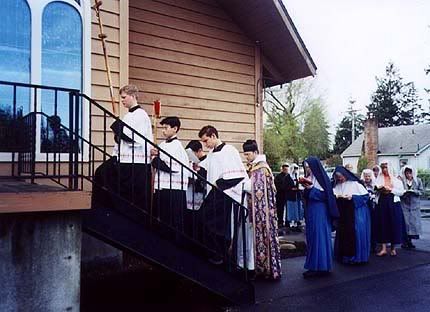
From The Liturgical Year, by Abbot Prosper Gueranger, OSB:
In the Greek Church, the fifth Sunday after Easter is called the Sunday of the man born blind, because her Gospel for the day contains the history of that miracle of our divine Lord. She also calls it Episozomene, which is one of the names given by the Greeks to the mystery of the Ascension, the feast of which is kept with them, as with us, during the course of this week.
The holy apostle, whose instructions these are, had received them from our risen Jesus: hence the authoritative tone wherewith he speaks. Our Saviour, as we have already seen, honoured him with a special visit. This proves that he was particularly dear to his divine master, to whom he was related by the tie of consanguinity on his mother's side, whose name was Mary. This holy woman went on Easter morning to the sepulchre, in company with her sister Salome, and Magdalene. St. James the Less is indeed the apostle of Paschal Time, wherein everything speaks to us of the new life we should lead with our risen Lord. He is the apostle of good works, for it is from him that we have received this fundamental maxim of Christianity, that though faith be the first essential of a Christian, yet without works it is a dead faith, and will not save us.
He also lays great stress on our being attentive to the truths we have been taught, and on our guarding against that culpable forgetfulness, which plays such havoc with thoughtless souls. Many of those who have this year received the grace of the Easter mystery, will not persevere; and, the reason is, that they will allow the world to take up all their time and thoughts, whereas they should use the world as though they did not use it. [I Cor. vii. 31.] Let us never forget, that we must now walk in newness of life, in imitation of our risen Jesus, who dieth now no more.
The two Alleluia-versicles celebrate the glory of the Resurrection; but they also contain an allusion to the approaching Ascension. Jesus was born eternally from the Father; He came down to us; but now, in a few days, He is to return to his Father.
When, at His last Supper, our Saviour thus warned His apostles of His having soon to leave them, they were far from knowing Him thoroughly. True, they know that He came forth from God; but their faith was weak, and they soon lost it. Now that they are enjoying His company after His Resurrection, now that they have received such light from His instructions, they know Him better. He no longer speaks to them in proverbs; He teaches them everything they require to know in order to become the teachers of the whole world. It is now they might truly say to Him: We believe that thou camest forth from God! So much the more, then, do they understand what they are going to lose by His leaving them.
Our Lord begins now to reap the fruit of the word He has sown in their hearts: oh! how patiently has He waited for it! If He praised them for their faith, when they were with Him on the night of the last Supper, He may surely do so now that they have seen Him in the splendour of His Resurrection, and have been receiving such teaching from His lips. He said to them, at the last Supper: The Father loveth you, because ye have loved Me; how much more must the Father love them now, when their love for Jesus is so much increased! Let us be consoled by these words. Before Easter our love of Jesus was weak, and we were tepid in His service; but now that we have been enlightened and nourished by His mysteries, we may well hope that the Father loves us, for we love Jesus better than we did before. This dear Redeemer urges us to ask the Father, in His name, for everything we need. Our first want is perseverance in the spirit of Eastertide; let it be our most earnest prayer; let it be our intention now that we are assisting at the holy sacrifice, which is soon to bring Jesus upon our altar.
The Offertory is taken from the Psalms; it is an act of thanksgiving which the Christian, united with his risen Jesus, offers to God for having brought him to the new life, and made him the object of His choicest graces.
Labels: The Liturgical Year
Daily Marian Prayer And Image

From The Glories Of Mary, by Saint Alphonsus de Liguori:
O most pure Virgin Mary, I venerate thy most holy heart, which was the delight and resting-place of God, thy heart overflowing with humility, purity, and divine love.
I, an unhappy sinner, approach thee with a heart all loathsome and wounded. O compassionate Mother, disdain me not on this account; let such a sight rather move thee to greater tenderness, and excite thee to help me. Do not stay to seek virtues or merit in me before assisting me. I am lost, and the only thing I merit is hell. See only my confidence in thee and the purpose I have to amend. Consider all that Jesus has done and suffered for me, and then abandon me if thou canst.
I offer thee all the pains of his life; the cold that he endured in the stable; his journey into Egypt; the blood which he shed; the poverty, sweats, sorrows, and death that he endured for me; and this in thy presence. For the love of Jesus, take charge of my salvation.
O, my Mother, I will not and cannot fear that thou wilt reject me, now that I have recourse to thee and ask thy help. Did I fear this, I should be offering an outrage to thy mercy, which goes in quest of the wretched, in order to help them.
O Lady, deny not thy compassion to one to whom Jesus has not denied his blood. But the merits of this blood will not be applied to me unless thou recommendest me to God. Through thee do I hope for salvation. I ask not for riches, honors, or earthly goods. I seek only the grace of God, love towards thy Son, the accomplishment of his will, and his heavenly kingdom, that I may love him eternally.
Is it possible that thou wilt not hear me? No; for already thou has granted my prayer, as I hope; already thou prayest for me; already thou obtainest me the graces that I ask; already thou takest me under thy protection. My Mother, abandon me not. Never, never cease to pray for me, until thou seest me safe in heaven at thy feet, blessing and thanking thee forever.
Amen.
Labels: Our Blessed Lady



